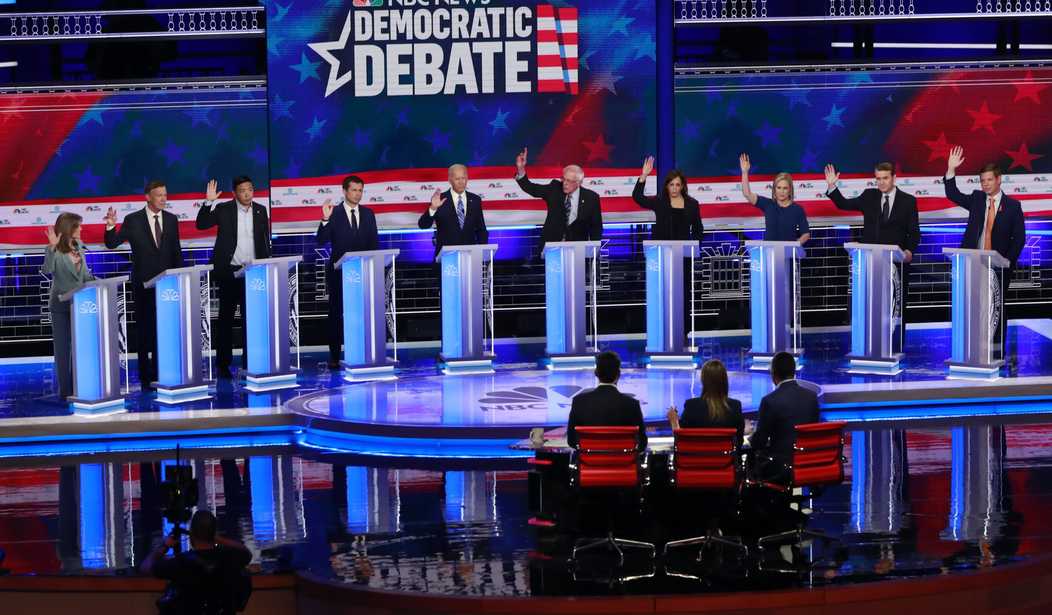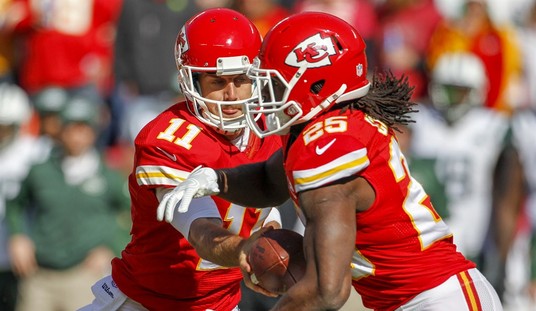In May, New York Mayor Bill de Blasio announced his candidacy for the 2020 Democratic presidential nomination. Extremely unpopular in his own state and polling at zero, de Blasio had the distinction of being told not to run, by his own constituents. Last week, hedge fund billionaire and climate change activist Tom Steyer announced his own candidacy. Steyer had counted himself out in January, so he too was polling at zero percent. Also last week, Rep. Eric Swalwell (D-Calif.) suspended his long shot campaign. Former Gov. John Hickenlooper (D-Colo.) is bleeding staff and money, but is not dropping out.
In 2015, I wrote a story probing the hidden motives behind the huge Republican primary — when there were only 17 candidates. Those were the days! Now there are roughly 25 candidates in the Democratic race. There are so many Democrats in the race, the DNC actually had to alter their standards for the second round of debates next week in order to exclude former Sen. Mike Gravel (D-Ala.) and keep the debates down to two nights of 20 candidates each. (Gravel got the required number of donors, but the DNC used polling data to thin out the herd.)
In the 2016 Republican primary, governors and former governors like Bobby Jindal, John Kasich, Rick Perry, Chris Christie, Jim Gilmore, and George Pataki ran for president — with little hope of success. Even Gov. Scott Walker (R-Wisc.), beloved by many conservatives, fell far short and dropped out early.
In the 2020 Democratic primary, many candidates have no chance of winning. As the race is shaping up, only five candidates have emerged as serious contenders: former Vice President Joe Biden, Sen.s Bernie Sanders (I-Vt.), Elizabeth Warren (D-Mass.), Kamala Harris (D-Calif.), and South Bend, Ind. mayor Pete Buttigieg. The few less radical candidates seem stuck at the bottom of the polls. While it is possible for a dark horse to emerge, it is rather unlikely.
According to the RealClearPolitics polling average, ten of the twenty considered candidates are polling below 1 percent (the polls do not include a few of them). Sen.s Cory Booker (D-N.J.) and Amy Klobuchar (D-Minn.) are stuck between 1 percent and 2 percent, along with Rep. Tulsi Gabbard (D-Hawaii) and entrepreneur Andrew Yang.
So why are they running? Why are they spending months — perhaps as much as a year — of their lives raising money, debating more serious candidates, and desperately fishing for media coverage? Don’t they have anything better to do?
In July 2009, popular Gov. Sarah Palin (R-Ala.) decided to resign. This made little sense at the time, but her decision came with a huge pay day. As governor, Palin made $125,000 per year. “Deep down, she wanted to make money,” one of former presidential candidate John McCain’s former advisors told New York Magazine. “There was always financial stress. They’re not wealthy people.”
Palin left the governor’s mansion to become — in essence — a full-time campaigner. In May 2009, she signed a $7 million book deal with Harper Collins and went on tour. According to the Washington Speakers Bureau (which lists George W. Bush and Rudy Giuliani as clients), she made $100,000 per speech. In the year after resigning as governor, she made $12 million.
Before Ben Carson became Trump’s secretary of Housing and Urban Development, his post-neurosurgeon career netted him $27 million for delivering 141 speeches and publishing three books. Sen. Ted Cruz (R-Texas) made made $1.5 million for his campaign book. Carly Fiorina racked up almost $1 million for speeches and sales of her memoir. New York Magazine‘s Gabriel Sherman wrote that the 2016 primary seemed like “less of a political party and more like a talent agency for the conservative media industry.”
Every presidential candidate receives free hours of TV, radio, and internet attention, with the promise of bigger things to come. “Even if you lose, you exponentially increase your marketability,” aa Republican consultant said in 2015. How much more true is this for Democrats, whose liberal ideology dominates Hollywood, most of the mainstream media, and universities?
As in 2016 with Republicans, the cashing in has already begun. Kamala Harris received a $446,875 advance for her political memoir The Truths We Hold, along with an additional $49,9000 for a young reader’s edition, POLITICO reported. She also got $60,000 for her children’s book Superheroes Are Everywhere. She reported gaining $320,000 for books in her 2018 tax return submitted in April.
Bernie Sanders reported $391,000 in book royalties between 2018 and spring 2019. Ironically, Sanders became one of those “millionaihrs” he loves to hate — by running for president. Amy Klobuchar received a $27,000 advance for an upcoming book, and took in less than $200 in royalties for her 2015 memoir The Senator Next Door.
Elizabeth Warren gained a $300,000 advance for her 2017 book This Fight Is Our Fight, and Cory Booker earned more than $400,000 from book sales in 2016 and 2017.
It seems Pete Buttigieg rushed the gun with his memoir Shortest Way Home, which he signed a deal for in 2017. He received a $75,000 advance and royalties and a narration fee have netted him only $3,000 between the start of 2018 to May 2019. Yet Buttigieg already has a film in the works, and it seems likely the documentary about his presidential run will net him a good amount of cash.
Most of these candidates are in the top tier, yet even candidates in the bottom tier can count on increased media profiles, boosting future advances and book sales.
Many candidates may be running to win political favors — a seat in the next presidential administration. Former President Barack Obama chose one primary challenger as vice president (Joe Biden) and another as secretary of State (Hillary Clinton). President Donald Trump nominated Rick Perry for the Department of Energy and Ben Carson for HUD. 2020 Democratic candidates like Sen. Michael Bennet (D-Colo.) may not become the nominee, but he could land a job in a potential Democratic administration.
Perhaps the biggest ulterior motive for running for president is an attempt to push a political party to embrace your policy goals. Bernie Sanders achieved this in 2016, driving Hillary Clinton further left and increasing his own profile in the process. Sanders racked in cash and had his policy goals taken seriously by the party he refused to even join. His policy goals are already driving the 2020 debates, from Medicare for All to tuition-free college education.
Many of these ulterior motives could explain the presence of second- or third-tier candidates such as Julián Castro, Gov. Steve Bullock (D-Mont.), former Rep. John Delaney (D-Md.), Gabbard, Gillibrand, Hickenlooper, Gov. Jay Inslee (D-Wash.), Klobuchar, former Rep. Robert Francis “Beto” O’Rourke (D-Texas), Rep. Tim Ryan (D-Ohio), Marianne Williamson, and Yang in the race. Yang, in particular, is pushing the issue of universal basic income.
Money, a profile, influence, and cabinet positions as ulterior motives explain huge presidential primaries, but there are two candidates who seem unlikely to benefit in these ways. Mayor de Blasio is unpopular and already has a big profile — perhaps he just wants to escape the city that now hates him. Similarly, Tom Steyer already has money and influence. He may score a cabinet position, but he could have gotten that through a hefty donation to the eventual primary winner. In either case, cabinet positions can only come to them if the Democrat wins in November 2020 — and even then, they still need to curry favor.
Sometimes, candidates run for president just to say they’ve done it. Perpetual candidates like Vermin Supreme — the guy with the boot on his head — seem to like the attention. There’s still a clear difference between Vermin Supreme and Bill de Blasio, however. Vermin Supreme is likely more popular with New York voters.
Whatever the candidates’ stated reasons for running, Americans should be well aware of the possible ulterior motives behind those five little words, “I am running for president!”
Follow Tyler O’Neil, the author of this article, on Twitter at @Tyler2ONeil.









Join the conversation as a VIP Member